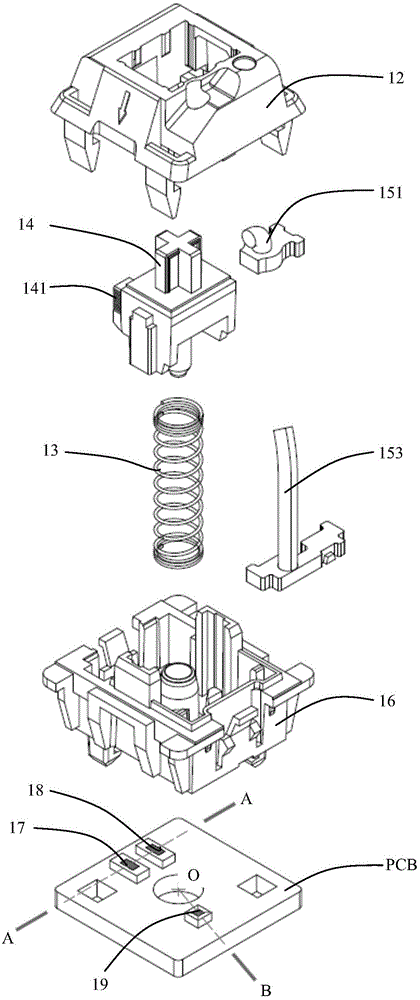Switch module controlling and adjusting photoelectric signals to be input into device
A switch module and photoelectric signal technology, which is applied in the fields of photoelectric and light-conducting game mouse button switches and photoelectric and light-conducting mechanical axis keyboard switches, which can solve the problems of reduced key sensitivity, low optical coupling efficiency, false touches, etc.
- Summary
- Abstract
- Description
- Claims
- Application Information
AI Technical Summary
Problems solved by technology
Method used
Image
Examples
specific Embodiment approach 2
[0085] The photoelectric light-conducting type mechanical axis keyboard switch module involved in the present invention, its specific embodiment 2 is another kind of eccentric keycap character lighting system, which adopts SMD LED19 (chip type light-emitting diode, which can be red and green Blue and white LEDs of various colors) combined with the structure of the eccentric light guide column 253, the position of the SMD LED19 is designed to deviate from the center of the keycap characters, and through a special light distribution design, as in this specific embodiment, the bottom of the light guide column 253 is close to The part of the LED is set as a Fresnel curved surface 253-1 with a light-gathering effect, and the end surface of the light guide column 253 close to the keycap characters is set as a light-emitting surface 253-2 with a certain inclined angle, that is, the light-emitting surface 253-2 is inclined. The plane or curved surface of the keycap characters can be ev...
specific Embodiment approach 3
[0087] The light guide system of the button switch used to effectively control and adjust the photoelectric signal involved in the present invention, the switch control principle of its specific embodiment 3 is as follows Figure 10 shown. The light guide 151 above the SMD PT tube 18 on the left side is the same as that of Embodiment 1. The difference in this embodiment is the light-gathering surface 341-3 below the free-form surface condensing prism 341 above the SMD IR tube 17 on the right side. Instead, it has more than one sawtooth-shaped oblique-axis Fresnel surface. The optical axis of the oblique-axis Fresnel surface is CX, and it is inclined toward the direction of the microstructure surface 341-1. The oblique-axis Fresnel surface 341-3 converges the light emitted by the SMD IR tube 17 onto the microstructure surface 341-1. The microstructure surface 341-1 is a zigzag total reflection Fresnel surface, or a microprism array surface with total reflection effect, a micro...
specific Embodiment approach 4
[0090] The light guide system of the button switch used to effectively control and adjust the photoelectric signal involved in the present invention, the switch control principle of its specific embodiment 4 is as follows Figure 11 shown. The converging and turning device on the top of the SMD IR tube 17 on the right side adopts the same free-form surface prism 141 as that of the specific embodiment 1. What is different in this embodiment is that the original light-gathering surface 151-1 on the top of the left side SMD PT tube 18 Instead, it is a condenser lens 452 that is separated from the light guide 451 . The condensing lens 452 is a plano-convex lens or a convex-convex lens, which converges the light in the light guide 451 into the SMD PT tube 18 below.
[0091] Its working principle is: when the button is pressed down, the cross key shaft moves down together with the free-form prism 141, and when it moves to a certain position, the left output end surface of the free-...
PUM
 Login to View More
Login to View More Abstract
Description
Claims
Application Information
 Login to View More
Login to View More - R&D
- Intellectual Property
- Life Sciences
- Materials
- Tech Scout
- Unparalleled Data Quality
- Higher Quality Content
- 60% Fewer Hallucinations
Browse by: Latest US Patents, China's latest patents, Technical Efficacy Thesaurus, Application Domain, Technology Topic, Popular Technical Reports.
© 2025 PatSnap. All rights reserved.Legal|Privacy policy|Modern Slavery Act Transparency Statement|Sitemap|About US| Contact US: help@patsnap.com



